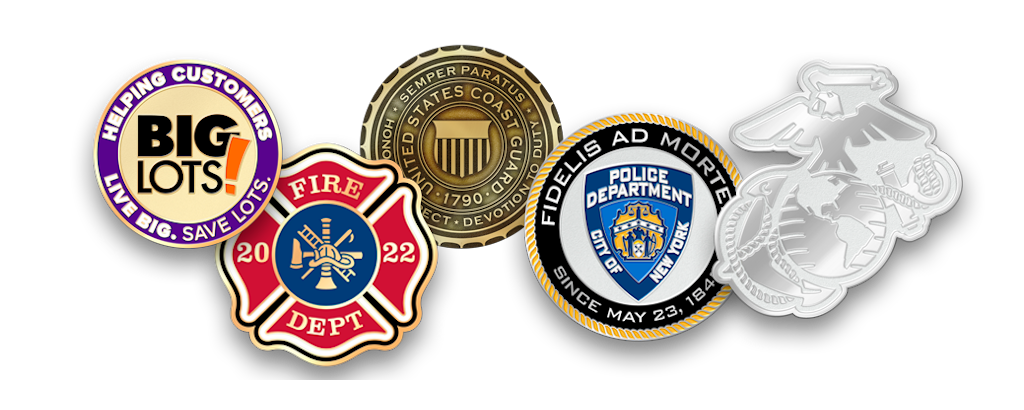Are you familiar with challenge coins? If you’re in the military or law enforcement, you’ve undoubtedly heard of them. You probably even own some.
But did you know that these distinctive coins are also used by other organizations, from schools and businesses to sports teams, nonprofits, and fan clubs?
What’s more, their popularity is growing – and with good reason. These classy commemorative coins provide an inexpensive yet meaningful way to boost morale, reward achievement, and build team cohesion. No wonder so many people love them!
What, Exactly, Are Challenge Coins?
Technically, they’re not coins at all. Though they’re often exchanged and bartered, they don’t function as official legal tender. Rather, these metal medallions serve a range of other purposes:
- As identification in “coin check” challenges – more about this below!
- As proof of membership in clubs or groups
- As keepsakes and mementos
- As treasured collectibles
- As rewards recognizing years-of-service and/or special accomplishments
- As awards for high-achieving students
- As morale-building giveaways for sports teams or company employees
- As promotional giveaways to build brand or product awareness
Like lapel pins, challenge coins are typically made of a soft yet sturdy metal like copper, iron, or brass. Also like lapel pins, they’re available in several versions:
- Soft enamel – an affordable, colorful option with a richly embossed texture
- Hard enamel – sleek and smooth, for that elegant cloisonné look
- Die-struck (with no enamel color-fill) – simple and sophisticated
- Offset printed – with amazing photo-realism
Unlike lapel pins, though, challenge coins aren’t meant to be worn, so they have no backings or clutches. Plus, they tend to be bigger – up to 4 inches tall.
What’s the Origin of Challenge Coins?
Nobody knows exactly when and where challenge coins first appeared. Some people say they once served as identification for members of persecuted religious groups. If you showed your challenge coin, you could gain admittance to the group’s secret meetings. Owning the special coin meant you were a bona fide member, not a spy attempting to infiltrate the group.
Other people trace challenge coins back to World War I. Supposedly a US flying squadron was stationed somewhere in France. The unit’s lieutenant gave solid bronze coins – each bearing the squadron insignia – to all of the airmen under his command. One young American pilot slipped his coin into a small leather pouch and hung it around his neck. Later he was shot down over enemy lines and captured by the Germans. Fortunately he escaped – stripped of all his IDs except his coin – and made his way back to French territory. However, the French officials thought he was a spy and prepared to execute him. That’s when the pilot pulled his bronze medallion out of his leather pouch and showed it to the French. They recognized his squadron’s insignia, realized that he was an ally, promptly spared his life – and gave him a bottle of wine!
Once the pilot was reunited with his squadron, he related his colorful experience. Thereupon a tradition was born. From then on, squad members could demand to see an airman’s challenge coin. If he couldn’t produce it, then all the drinks at the local bar were on him.
This “coin check challenge” became popular among members of the armed forces, both in the US and in Great Britain. The rules of the game varied, but in general they went something like this:
- A fellow soldier or sailor would ask you to show your challenge coin (bearing your squad’s insignia).
- If you couldn’t produce it, you’d buy your mates a round of drinks.
- If you could produce your coin, but your challenger couldn’t, then he or she would buy the drinks.
In recent years, some military authorities have cracked down on drinking games like these. But the “challenge” concept persists. To this day, these keepsake coins are still used to ID club and group members – people who share special interests and experiences. Plus, military commanders still award them to service members in recognition of notable achievements.
As mentioned above, these cherished coins have a wide range of other uses, too. So, whether you’re rewarding your top employees, fundraising for a school or charity, trading collectible keepsakes, or hosting a family reunion, you’ll want to consider ordering challenge coins.
How to Place Your Order
Have a rough idea for a challenge coin? Need help finalizing your design? Our highly skilled artists can help. Simply send us your basic concept, and our designers will expertly transform it into finished digital artwork. Throughout the process, of course, you’ll get to vet and approve the design. We’ll make sure it exactly meets your specifications.
If you already have a digital design, so much the better. We’ll gladly work with your artwork to produce your custom coins.
In addition, you’ll need to determine:
- Whether you’ll want soft enamel, hard enamel, die-struck, or offset coins
- What size to order – anywhere from 1.5 to 4 inches
- What quantity you’ll need, from 50 to 2,000
- What metal you’ll want: brass, copper, or iron
- Whether you’d like any additional decorative touches
If you’re not sure about any of these variables, talk to our representative. He or she can make recommendations based on your specific needs. Why not get started today?

